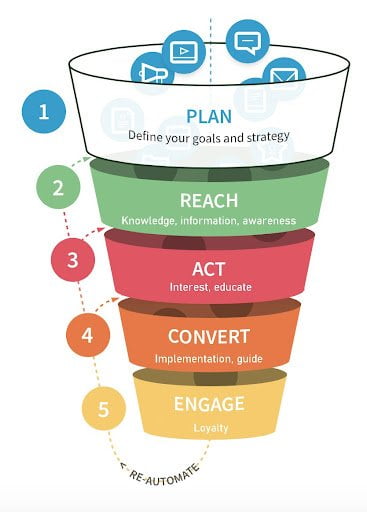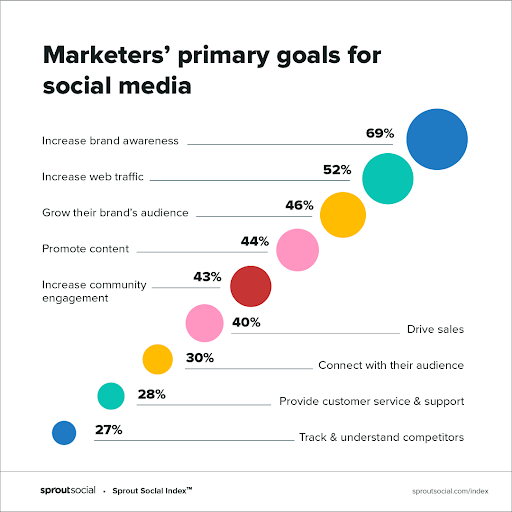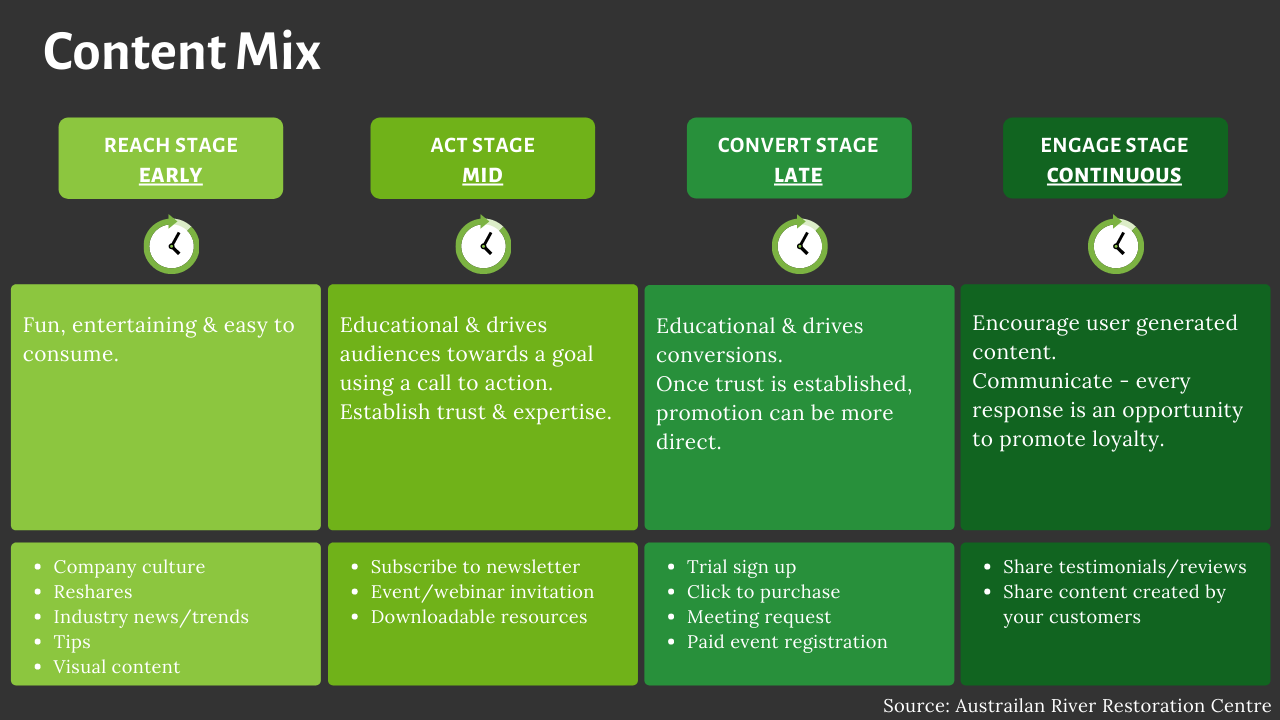 Masha Artamonova
Masha Artamonova
Digital Marketing Specialist
A social media strategy is a blueprint of your planning and implementation processes that allows you to reach your social media marketing objectives. Here’s a guide on how to structure a data-driven social media marketing strategy for an organisation within the environmental services sector. This includes consultancy, research, not-for-profit and government organisations.
Why social media?
Social media provides a wealth of opportunities, such as brand awareness, reaching your specific audience, building loyal relationships, and increasing website traffic. It makes you top of mind for those who are in the market for your services, or encourages future connections with those who are not yet aware of what you offer. However, social media is not about saturating every possible platform with 24/7 content. That would be way too time consuming, and probably offer a limited return for your efforts. A good social media strategy involves looking at the goals that are specific to you, and working out how to achieve them.
45% of active users say they use social networks when researching brands
Source: Global Web Index
A social media strategy should consider audiences at each stage of their relationship with a business, as decisions will differ at each stage. This can be organised through a marketing funnel, which maps out the typical decision process your target audience will follow. This guide will consider the Smart Insights RACE framework (Reach > Act > Convert > Engage), which can then be tailored to the needs of your organisation.

How does this apply to services marketing?
Services marketing, especially environmental services, is often more focused on trying to sell ideas, messages and solutions rather than products. The marketing strategy often has a stronger focus on stakeholder awareness, engagement, and communications, rather than product sales. When it comes to environmental services, each consumer RACE stage has a slightly different layer. Your funnel may look more like the image below.

It is important to note that these stages work simultaneously. Not everyone starts at R and not everyone ends at E. People will come in at random times and a social media strategy should ideally consider all of the stages, all of the time.
This guide will look at the following four steps for a social media strategy:
1. Situational analysis and target audience
2. Objectives
3. Strategy
- Content mix and how to produce engaging content
- Channel mix
- Schedule
- Analytics
- Community engagement
- How to manage negative feedback
1. Situational Analysis
A situational analysis asks, ‘where are we now?’. It involves looking at your current position, your customers, your competitors, and what opportunities exist. In relation to your social media strategy, consider the following questions:
- What value do you offer your audience and why?
- Who are you targeting?
It’s useful to build a buyer persona to define your audience and help you craft content that is relevant to them. A buyer persona considers your audience’s background, goals, their pain points and how you can address them, and how they like to consume content. The data you collect from your social media efforts will help you refine this persona over time.
The buyer persona will help with the following questions for each stage:
Reach Stage
- How will you grab your target audience’s attention?
- What is the content they are currently engaging with and how can you mirror that with your own?
Act Stage
- Now that they know who you are, how will you make them take the next step?
- What value can you give them or how can you actively engage them? (e.g. free consultation, monthly newsletter)
- What are potential barriers that might prevent them from engaging?
Convert Stage
- What problems are you trying to solve and what value can you give?
- How do you promote that value?
- How do you deliver that value?
- What makes your offering unique?
Engage Stage
- Who are the people that return or consistently engage?
- Are they aligned with who you are targeting?
- What information can they give about which part of your social media strategy is performing well?
- Are they willing to advocate your service?
2. Objectives
Social media objectives guide the strategy and help with planning and decision making. Social media objectives should be in line with your overall organisational goals. When creating actionable goals, they should be measurable and set within a certain timeframe.

Objectives may vary at each funnel stage. Common objectives are as follows:
Reach Stage
- This stage is where your audience sees that your service exists.
- Objectives may include: reach, engagement, video views, re-shares, follower growth, and brand awareness.
- To decide on quantifiable benchmarks, research into the industry averages for your organisation. The size of your audience and what you want to achieve will also impact objectives at this stage. For example, brands with larger, unengaged audiences may average 1-2% engagement rate on Facebook. If you are a small organisation that wants to use social media to build a community beyond general awareness, your benchmark engagement rate should be higher.
- According to AdEspresso, the average organic reach for a Facebook post is 5.2% of a page’s total likes – although this depends on how consistent and engaged a business is with the platform.
Act Stage
- This stage is about encouraging your audience to take the next step after finding out who you are. Unless your entire organisation is based on social media, this will often include leading your audience to your website. This can be done using call to actions on social media posts, which is when you provide links or incentives for someone to visit your site. This tends to work well when content is relevant and adds value to the consumer.
- Objectives may include: link clicks and click through rate (how many post impressions resulted in a link click), subscriptions, resource downloads, and lead generation.
Convert Stage
- This is where you achieve your primary business objective, whether that is a sale, resource download, or newsletter or webinar subscription. Messaging across social media and website platforms should remain consistent and encourage the target audience to convert.
Engage Stage
- This stage is where people that have already converted continue to engage with your brand. These are the loyal followers, regular commenters, and advocators that share their experiences. Nurturing these relationships is crucial, as it is cheaper to keep existing customers than acquire new ones. Research shows that increasing customer retention rates by 5% increases profits by at least 25%.
- Objectives may include: retention rate (how much of your audience returns), reviews and testimonials, conducting surveys to collect feedback and responding to suggestions, and engaging an audience to advocate your service by creating user generated content (where they share their own content that promotes your service).
For metrics to measure the success of each objective, see Measurement and Control.
3. Strategy
A strategy involves developing a fit between objectives and capabilities in a climate of changing market opportunities. It is looking at your goals and deciding how to get there.
For social media, a strategy includes elements such as content mix (what you are posting), channel mix (where you are posting), and schedule (when you are posting), as well as using data to support your decisions.
Content Mix
A content mix is all the types of content that are relevant to your organisation and provide value to your audience. Depending on your organisation, types of content can include:
- informative blogs/articles
- guides
- information about your organisation and its purpose
- live videos
- infographics
- memes/comics
- podcasts
- images
- industry news
- customer photos/testimonials
- downloadable resources e.g. ebooks, events, webinars
- sharing external content
In addition to the types of content, your content will have a purpose behind it. Looking at content through the categories of early, mid, and late stage messaging helps to see if a varied mix is being achieved.
The content mix you choose will depend on what messages you want to share and who you are trying to reach.

This post by WWF-Australia is a great example of a ‘convert stage’ post. The video content is relevant to all Australians, drawing attention to the clear conversion objective of signing up. There is also an incentive provided with the call to action, where a native tree will be planted for each sign up, encouraging audiences to take the next step.
A good content mix should do more than push your conversion event (e.g. sales). People follow organisations on social media for the value the organisation provides to them, rather than the value they provide to the organisation. Engaging organisations tell stories, nurture relationships and create a sense of community. There are many guides available to ensure a balanced content mix. One common social media distribution framework is the 4-1-1 rule. For every four educational or entertaining posts that are shared, share one mid-stage promotion and one late-stage promotion.
How to produce engaging content?
Whether content is engaging or not is ultimately determined by the target audience. It is important to trial different techniques to see what works for you, but some methods include: attention grabbing first sentences (asking questions, new research, a unique statistic), good quality and colourful images or graphics, and not having too much text (depending on the social platform).
It can be effective to grab someone’s attention first, and if they are interested they will put in the effort to follow through on the desired outcome e.g. clicking a link or watching a video.
It is also beneficial to encourage engagement, ask questions, and relate to your audience on a personal level. Start a conversation where they can share their personal experiences, and make sure to be responsive to maximise on this engagement.
Need some inspiration? Look into what other organisations in your industry are doing that’s working well, then take it and make it even better.
Channel Mix
There are a number of social media platforms available to reach and engage with audiences. When choosing which ones to use, consider your objectives, your buyer persona, what platforms they use and how they like to consume content. Some platforms may be more suited for meeting your early stage objectives (e.g. reach, act) while others may be more targeted for later stages. Consider the features of each social media platform and what targeting and paid media opportunities they have available. Many platforms offer more ways to engage an audience than just posting to a feed. For example, Facebook and LinkedIn groups provide opportunities to create or join an engaged community and interact with people there.
Hot Tips:
- Create a Facebook/LinkedIn group for your customers and brand advocates, or an industry group for professionals within your target audience, and encourage community engagement.
- Use live videos on Facebook/Instagram to engage your audience in the moment. Research from Facebook shows that people spend 300% more time watching a Facebook Live video than one that is shared later.
- Facebook and Instagram stories are a great way to post more frequently without overwhelming audiences, as well as provide immediate updates.
- Make sure all visual content is optimised for the platform it is being posted on. This page provides the recommended image/video sizes for posts on different platforms.
Common social media platforms include Facebook, Instagram, Youtube, Twitter, LinkedIn, TikTok, Pinterest, and Snapchat. Overlapping content across platforms is a great way to reduce content creation load, but posts should always be repurposed and contextualised to what users expect from the platform. A lengthy article might not suit Instagram, but you can pull out smaller pieces of interesting content and design graphics to visually engage an audience with the article’s themes.
For example, the Managing Blackberries guide we published is text-heavy and doesn’t work for Instagram, where users come to follow human experiences. Instead, we posted a short IGTV video that showed experts demonstrating techniques used to control blackberry plants. While the post kept the theme of the original guide, it was more suited to Instagram due to being visual and people-based.
View this post on Instagram
Schedule
It is a great idea to use a content calendar to plan ahead and ensure that your content mix is spaced out – either create your own spreadsheet or there are limitless downloadable resources online. Automated scheduling tools are also beneficial. There are a number of third party platforms for this (such as Hootsuite or Later), but many social media platforms also allow you to schedule directly through their scheduling tools.
When’s the best time to post?
Research suggests that the best time to post for Facebook and LinkedIn is weekday mornings between 8am – 1pm, while Instagram is between 7pm – 9pm. Ultimately it is important to use data that is impactful to you and your industry. Consider when your target audience is engaging with social media, and then once you’ve started posting, use individual platform analytics tools to see the best performing times for your organisation.
4. Measurement and Control
This is where the success of your social media efforts are calculated, as well as the time to consider any changes that need to be made.
Analytics
It is easy to get lost in analytics and counting meaningless statistics, so it is important to ensure that you are gathering data that is specific to your objectives. Key performance indicators (KPIs) are specific measures designed to evaluate the effectiveness of your social media strategy based on your objectives at each stage.
Reach Stage
Common objectives: reach, engagement, video views, reshares, follower growth, and brand awareness.
Metrics to consider:
- Reach over time
- Engagement rate (%) = engagements / reach x 100
Engagements may include reactions, shares, comments, and clicks on links and videos. Engagement rates show which content resonantes best with your audience and should be continued. - Follower growth
This can be measured numerically or as a growth rate percentage over time. - Growth rate (%) = new net followers / total audience x 100
Act Stage
Common objectives: link clicks and click through rate, subscriptions resource downloads, and lead generation.
Metrics to consider:
- Click through rate (CTR) (%) = link clicks / impressions x 100
Shows an insight into how compelling content is or if it’s reaching the right audience. It also shows how much your social media efforts are contributing to your website traffic. - Bounce rate (as a comparison against other sources of traffic e.g. organic Google search). A website bounce rate is the percentage of visitors who enter a site and leave before any page interaction. If the social media bounce rate is lower than other sources, it means that the social media campaigns are driving high-value traffic and targeting the right audience for your website offering.
- Time spent on landing page
If people are clicking on your social media post, they are most likely interested in the messaging. The landing page should continue this messaging and make the audience’s next step easy and clear. If they are clicking on your social media post and only spend a few seconds on the landing page, there is likely a disconnect between what they expect and what they receive.
Convert Stage
Metrics here are calculated depending on what the conversion is and how you plan on measuring traffic. Conversions can include actions such as subscriptions, downloading content, registering for a program, or making a purchase. For example, the conversion rate for a subscription might be:
Conversion rate (%) = subscriptions / number of unique visitors x 100
Here are 3 conversion rate formulas to use:
- Conversion rate (%) = conversions / number of sessions x 100
- Conversion rate (%) = conversions / number of unique visitors x 100
- Conversion rate (%) = conversions / number of leads x 100
With these calculations, the numerator will measure your conversions and the denominator will be how you measure your traffic (e.g. session count, unique visitors, or leads).
Engage Stage
Common objectives: retention rate, reviews and testimonials, survey feedback, user generated content.
The metrics here tend to use qualitative data. At this stage, the best way to respond is to read reviews and testimonials, and highlight any consistent trends in how people are engaging. Use these as opportunities for improvement and include them in your updated strategy. Although this data is not numerical, individual feedback is often the most in-depth and gives a clear picture of what works or should be improved.
While metrics can be compared against industry benchmarks (and this is useful for reporting purposes), it is also important to benchmark against your previous results to see if your strategy is working or needs to be adapted.
Ultimately, this data is only relevant to the extent that you are achieving your organisation’s goals, whether that’s conversions or general awareness.
Community Engagement
Every point of communication that you have with your target audience is an opportunity to build trust. It is important to monitor responses on your social media content, and acknowledge the time people take to engage with you by liking their comments and responding to questions. Building this relationship also encourages future engagement.
How to manage negative feedback and unpopular decisions
The broad nature of social media allows anyone to access public pages, meaning that people outside your target audience will sometimes come across your content. Due to an ongoing global climate conversation, with various opinions held by individuals, communities and countries, the environmental services sector often has to promote and share controversial opinions. This may result in backlash and negative responses. While it may be tempting to take these personally or to try and change peoples’ minds, these responses are often not an accurate or holistic reflection of the people who you are trying to engage.
When sharing content that may be controversial, keep your audience in mind, remembering that the content might not necessarily please people outside of this area.
It is also important to consider how engagement is an exchange of thoughts and ideas. It is a mutual conversation, not just one way, and therefore it is important to involve the audience in the decision-making process of “how we landed here”, not just “here’s where we landed”. This transparency provides audiences with the tools to come to their own conclusions, and will often resonate more positively.
While it may be tempting to take these personally or to try and change peoples’ minds, these responses are often not an accurate or holistic reflection of the people who you are trying to engage.
A final word
After implementing a social media strategy and gathering data, take the time to reflect on any implications and what has or hasn’t worked well. The most important part of a strategy is continuous improvement. This means making the required changes so that as time goes along your strategy is driven by data that works for you, rather than guesswork.
We’re keen to know
Did you find this resource useful? Did it raise any questions or thoughts? Let us know with a message below.
